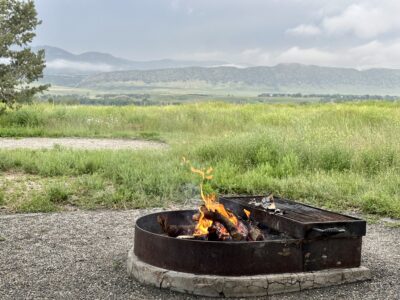You’re probably practicing gratitude wrong
You’re probably practicing gratitude wrong
You’re probably practicing gratitude wrong
Two weeks ago, my husband Jay and I went on vacation and took our RV to Colorado to see two of the last Grateful Dead shows on their final tour. Jay is a huge fan, what they call a “Dead Head”, and over the 15 years we’ve been together, I’ve grown to love them as well. Their energy is infectious.
It was our first day of the trip, and we were just outside of Abilene when, all of a sudden, we heard a huge BOOM! We pulled over and realized one of the trailer tires had all but exploded. The roads were so hot, you could fry an egg on them. It was 105 degrees outside. The heat index said that it felt like 120 degrees. It was 6pm, the town had one store, and that store was closed.
A young man named Garrett wandered over and asked if we needed help. Garrett was 19 years old and two of him would still weigh less than I do. Jay, being a guy, said, “No but thanks. We’re good”. Me being a smart person said, “Absolutely, yes, and thank you.” Shortly after, we were joined by Garett’s grandmother Pat, who could not have been sweeter.
Fortunately, we had a jack with us. Unfortunately, it was the wrong one. We were stuck. Pat suggested she call the town preacher. I thanked her but wasn’t quite sure how that would fix the tire. Pat giggled and said in her sweet Texas accent, “No hun. Preacher Mark has loads of tools”.
Pat was right. Preacher Mark showed up less than 10 minutes later. When he walked up to us, I immediately saw his gun and badge. Turns out Mark is not only the town preacher, he is also the town constable.
Mark came to the rescue with the right tool at the right time. While the guys worked on the tire, Pat told me all about her girl’s trips to Colorado when she was younger. Then, she took my hands, looked right into my eyes and said, “Hun, I am so grateful we were here to help you.” I gave Pat a hug and said, “We are the ones that are grateful. You saved us.”
After the tire was changed, Preacher Mark asked us to stand in a circle and hold hands. He then said a prayer for our safety on the remainder of our trip and expressed his gratitude that Pat called him. He had had a rough day, and helping someone made him feel better. That morning, Preacher Mark had been in a high speed chase when an inmate escaped from a local jail!
What started out as a bad situation, turned into a lesson in gratitude. One that set the tone for our entire trip.
What is gratitude and why is it the number one predictor of well-being?
Gratitude has two parts:
1. Being thankful and acknowledging the good that exists within our lives.
2. Sharing that appreciation with others.
Practicing gratitude does not mean that you ignore the negative or wear rose-colored glasses. It simply means that you actively search for what is good.
Seventy to 80% of our thoughts are negative and repetitive. Our brain looks for the path of least resistance and negative thoughts are easier. Negative experiences are immediately stored in long-term memory. Positive experiences require them to be held in awareness for several seconds to transfer from short to long-term storage. Since we rarely do this, many positive experiences flow straight through the brain. We spend a lot of time focusing on the negative, and repeated practice of any behavior becomes a habit.
Gratitude is a catalyst for positive emotions, triggering a cascade of physiological and psychological changes. Gratitude signals safety to our brain and activates the parasympathetic nervous system. This activation promotes relaxation, lowers heart rate, reduces blood pressure, and eases muscle tension, creating a sense of calm and well-being.
Practicing gratitude reduces the amygdala’s reactivity to negative stimuli, decreasing feelings of fear and anxiety. It activates areas in our brain associated with pleasure and reward, promoting the release of neurotransmitters like dopamine, oxytocin, and serotonin, which are known to enhance mood and regulate stress. The simple act of looking for something to be grateful for drops cortisol, the stress hormone, by 23%.
There are many different ways to practice gratitude, but to get the full benefit, your practice must contain these 3 things:
1. Savoring. You have to deliberately sustain and internalize positive emotions. When something good happens (a compliment, good meal, rock star parking, etc.) you have to sit in that “delicious moment”. Take a moment to “feel” the feelings of appreciation. You can’t just download the experience, you have to install it.
2. “Why” and “Because”. While it’s great to recognize good things in your life, you have to take it a step further. Why do you feel gratitude? For example, I am grateful for my incredibly talented team. I am grateful for them because I could not do what I do without them. Each has a unique set of skills and talents that builds our business, and they make my life and work infinitely better. (A huge thank you to Jay, Amy, Deena, Virginia, Tiffany, Kevin, Melissa, and Strother. I appreciate you so much).
3. Share it. The most important part of gratitude is often the most overlooked. When you feel gratitude towards someone, you must communicate it. It can be a text, email, note, phone call, or even a head nod, but you have to let the person know why you appreciate them. Send a text to someone right now and say something like, “I am grateful for you because.” On a side note, I once had a woman who texted her daughter, sharing her appreciation for her. The daughter texted back, “Mom, what’s wrong? Are you dying?”
Not only does gratitude impact your physical and mental health, it also builds and strengthens social connections, makes you appear more attractive and competent (who doesn’t want that?), and grows optimism. By practicing gratitude regularly, you can cultivate new neural pathways that contribute to an overall state of well-being and resilience.
I suggest integrating gratitude into your daily routine. For example, I practice gratitude when I brush my teeth. Twice a day, I focus on three things, people, places, experiences, pets, etc. that bring me joy and appreciation.
Back to the side of the road in Abilene…
We made it safely to our campsite. The next morning, we stopped and bought new tires. We continued on to Colorado and had the most amazing time. It was cooler, the mountains are my absolute favorite, and the Dead shows completely blew us away. They surprised over 50,000 fans by bringing Dave Matthews to the stage for the rest of the show. If you don’t know who Dave Matthews is, you need to. If you know, you know.
The show concluded with 70 drones that formed dancing bears, the coolest Dead logo, and a message that said, “Be Kind”.
And the fact that the band has “grateful” in the name, well, that was the cherry on top.
We camped, we lit fires, we laughed, and then we wrote down what we laughed about so we can savor it again later.
Gratitude is a powerful practice, one that will change your brain and your life.




Subscribe to Anne's #ResilienceReset Email!
Anne breaks down the daily habits and skills needed to grow and cultivate RESILIENCE.
If you can’t say something nice, don’t say anything at all.
Most of us are taught this simple lesson when we are kids. Unfortunately, it is not always practiced once we are adults. The human tendency to attribute our behavior to our intent and others’ behaviors to the type of person they are is referred to as the fundamental attribution error. Someone runs a stop sign, and we think they are a jerk. We run a stop sign and “oops”.
Regardless of our intentions, people only know what they see through our actions, and we only know what we see through the actions of others. In between our intentions and our actions lies a chasm.
How do you bridge the gap between intentions and actions? Try the following strategies 👆👆

Anne Grady is a Speaker, Author, and #TruthBomb Dropper.
Anne shares practical strategies that can be applied both personally and professionally to improve relationships, navigate change, and triumph over adversity. And she’ll make you laugh while she does it. Anne is a two time TEDx speaker, and her work has been featured in numerous media outlets, including Harvard Business Review, Entrepreneur, Forbes, Fast Company and Inc. magazines, CNN, ESPN, and FOX Business. She is the best selling author of 52 Strategies for Life, Love & Work and Strong Enough: Choosing Courage, Resilience and Triumph.

